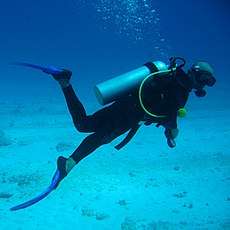Hazmat diving
Hazmat diving is underwater diving in a known hazardous materials environment. The environment may be contaminated by hazardous materials, the diving medium may be inherently a hazardous material, or the environment in which the diving medium is situated may include hazardous materials with a significant risk of exposure to these materials to members of the diving team. Special precautions, equipment and procedures are associated with hazmat diving.
Scope
Hazmat diving describes diving operations which involve risk of exposure to hazardous materials beyond the usual range encountered in professional diving operations.
Equipment
Most equipment used for hazmat diving is similar to other professional diving equipment, but may be modified to limit the risk of direct exposure of the diver and support personnel to the hazardous materials known or suspected to be present. The equipment appropriate to a hazmat diving operation will depend on the nature of the hazardous materials present and their potential effect on the diving team, and also to legislative constraints and the recommendations or requirements of codes of practice and organisational guidelines.[1]
Procedures
The procedures used in hazmat diving depend on the specific hazard and the assessed risks to health and safety of the diving team.

